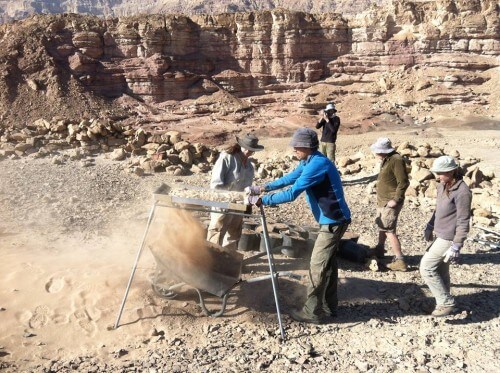According to the findings of researchers from Tel Aviv University, the "slaves" from the copper smelting site "Givat al-Ebadim" were in fact valued and revered craftsmen. The study is published in the prestigious journal Antiquity

New findings from the "Slave Hill" site in the Timna Valley indicate that those "slaves" were actually expert craftsmen, who lived like kings. The new study, which is published today in the journal Antiquity, was conducted by the delegation of Tel Aviv University to Timana, headed by Dr. Erez Ben-Yosef.
The "Hill of the Slaves" - located in the center of the Timna Valley, near the Temple of Hathor and the "Pillars of Solomon" - was first surveyed by the Jewish-American archaeologist Nelson Glick in 1934. Glick called the site "Slave Hill" because he assumed that the wall surrounding the hill was intended to imprison the workers there, who engaged in the hard work of copper mining in the desert climate.
In their new study, Dr. Erez Ben-Yosef and Dr. Lider Sapir-Chen from the Department of Archeology at Tel Aviv University reviewed food remains from the meals of the copper potters - food that was eaten about 3,000 years ago. The analysis of the remains shows that the workers at the site enjoyed a very high social status, even a religious worship. "What we found in Timna confirms a general historical fact regarding metal pots in antiquity," explains Dr. Ben-Yosef. "These craftsmen had a unique status in society."
It is the arid climate, unique to Tama, that allowed the researchers access to organic materials, which under other conditions would not have survived the passage of time: bones, seeds, fruits and even fabrics from the 10th century BC. Using wet sifting of the archaeological sediments, the team of researchers found bone fragments of mammals and fish at the site, which testify to the rich and varied diet of the coppersmiths in the mines, which were recently dated to the days of Solomon's reign.
"Make sure that the copper deaf live in the best possible conditions," says Dr. Sapir-Chen. "Examination of the remains of the meals, that is, of the bones of the farm animals, showed that they received the juiciest cuts of the meat, which certainly could not form the basis of the menu of slaves or cheap labor. The conclusions are also supported by the fish study, which was done in collaboration with Dr. Omri Larnau from the University of Haifa, which showed that the fish were brought to the site especially from the shores of the Mediterranean Sea, that is, from a distance of hundreds of kilometers. It was definitely not a slave's diet, but a menu of artisans of high social status. We also do not rule out the possibility that they were worshiped as religious priests."
Copper, which was used in ancient times to produce tools and weapons, was the most valuable resource in the societies of the ancient Middle East. According to Dr. Ben-Yosef, the deaf were well versed in the complex technology of turning stone into copper - a technology that was so complex for its time that it could easily be thought of as witchcraft. "From contemporary ethnographic reports, we know that metal deaf people are worshiped, even sacrificed to them."
Copper extraction is a complex process, requiring different stages and different levels of expertise. It is very possible that the early mine workers in Timna were indeed slaves or captives, since their task was simple in terms of skill - and difficult in terms of working conditions. But the act of smelting itself requires skill and leadership: the plowman had to build a clay furnace of very specific dimensions, supply this furnace with a precise amount of oxygen and coal, maintain a temperature of 1,200 degrees Celsius, blow in a constant amount of air and add a complex mixture of minerals to the cauldron.
It is therefore a process that requires 30-40 variables, and therefore the researchers assume that those involved in the craft were divided into work teams of different specialists. According to Dr. Sapir-Chen, the leftover food in Timna indicates a complex, even polarized, social structure of the workers there.
And as for the wall that gave the "Slave Hill" its name: the researchers believe that the fortified wall had a completely different function. "The wall was not intended to imprison the slaves," says Dr. Ben-Yosef. "On the contrary, it is designed to protect the expert craftsmen, their expensive technology and of course - the copper itself."
The research is part of the Tel Aviv University's renewed excavation project in the Timna Valley, which focuses on understanding the exploitation of natural resources by man in ancient times.










One response
Did they mine pure copper, or copper ore?
And if ore - what was the chemical process in which they separated the copper, and how did they know it?